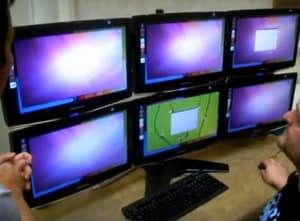Improving the Multi-Monitor Experience in Ubuntu
Canonical
on 20 December 2011
Tags: communication , Design , multi-monitor , Multi-screen , recent work , Ubuntu , user experience , ux
Over the past few months we have been working on improving the multi-monitor experience in Ubuntu. We took the opportunity at UDS in November to get some feedback on a prototype, which shows how we are planning to develop the multi-monitor experience over the next few cycles:
Here is a short video of the prototype in action at UDS:

http://www.youtube.com/watch?v=lbwNMnNUGFA
We invested in a six monitor rig and the prototype to test a number of different display configurations and to ensure that our design ideas scale well. However, our main focus for Precise is to ensure that we deliver a reliable and supportive experience for the core use cases, such as connecting to a second display or projector, disconnecting displays and using a closed laptop with an external display.
So here is the Phase 1 specification, scoped for the next couple of cycles, incorporating the feedback we got from the prototype and sessions at UDS:
http://design.canonical.com/the-toolkit/unity-multi-monitor-interactions/
Work continues now on the prototype, which will be used to conduct usability testing on the launcher, spread, window management and workspace interactions for multiple monitor setups. We will be publishing the prototype on this site (the Ubuntu prototype application, along with the Qt C++ source code) in the near future, so keep tuned for more Multiple Monitor news.
Talk to us today
Interested in running Ubuntu in your organisation?
